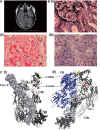Rare genetic variants in Shiga toxin-associated haemolytic uraemic syndrome: genetic analysis prior to transplantation is essential
- PMID: 28852487
- PMCID: PMC5569917
- DOI: 10.1093/ckj/sfx030
Rare genetic variants in Shiga toxin-associated haemolytic uraemic syndrome: genetic analysis prior to transplantation is essential
Abstract
We present a case of haemolytic uraemic syndrome (HUS) in a 16-year-old female with serological evidence of acute Escherichia coli O157:H7 infection. She progressed to established renal failure and received a deceased donor kidney transplant. Shiga toxin-associated HUS (STEC-HUS) does not recur following renal transplantation, but unexpectedly this patient did experience rapid and severe HUS recurrence. She responded to treatment with the terminal complement inhibitor eculizumab and subsequent genetic analysis revealed a rare variant in a complement gene. This highlights the importance of genetic analysis in patients with STEC-HUS prior to renal transplantation so that management can be individualized.
Keywords: STEC-HUS; atypical haemolytic uraemic syndrome; complement; eculizumab; renal transplantation.
Figures

Similar articles
-
Eculizumab in the treatment of Shiga toxin haemolytic uraemic syndrome.Pediatr Nephrol. 2019 Sep;34(9):1485-1492. doi: 10.1007/s00467-018-4025-0. Epub 2018 Jul 30. Pediatr Nephrol. 2019. PMID: 30058046 Free PMC article. Review.
-
Outcome of children with Shiga toxin-associated haemolytic uraemic syndrome treated with eculizumab: a matched cohort study.Nephrol Dial Transplant. 2020 Dec 4;35(12):2147-2153. doi: 10.1093/ndt/gfz158. Nephrol Dial Transplant. 2020. PMID: 31411695
-
Antibody response to lipopolysaccharides and recombinant proteins of Shiga toxin (STX)-producing Escherichia coli (STEC) in children with haemolytic uraemic syndrome in Poland.Lett Appl Microbiol. 2020 Jun;70(6):440-446. doi: 10.1111/lam.13295. Epub 2020 Apr 28. Lett Appl Microbiol. 2020. PMID: 32270510
-
CFH and CFB mutations in Shiga toxin-associated haemolytic uraemic syndrome in a 6-year-old boy.Paediatr Int Child Health. 2020 May;40(2):129-131. doi: 10.1080/20469047.2019.1616458. Epub 2019 Jun 27. Paediatr Int Child Health. 2020. PMID: 31242818
-
Shiga toxin-induced haemolytic uraemic syndrome and the role of antibiotics: a global overview.J Infect. 2019 Aug;79(2):75-94. doi: 10.1016/j.jinf.2019.05.018. Epub 2019 May 28. J Infect. 2019. PMID: 31150744 Review.
Cited by
-
Thrombotic Microangiopathy and the Kidney.Clin J Am Soc Nephrol. 2018 Feb 7;13(2):300-317. doi: 10.2215/CJN.00620117. Epub 2017 Oct 17. Clin J Am Soc Nephrol. 2018. PMID: 29042465 Free PMC article. Review.
-
Haemolytic uremic syndrome: diagnosis and management.F1000Res. 2019 Sep 25;8:F1000 Faculty Rev-1690. doi: 10.12688/f1000research.19957.1. eCollection 2019. F1000Res. 2019. PMID: 31598213 Free PMC article. Review.
-
Complement in Secondary Thrombotic Microangiopathy.Kidney Int Rep. 2021 Jan;6(1):11-23. doi: 10.1016/j.ekir.2020.10.009. Epub 2020 Oct 21. Kidney Int Rep. 2021. PMID: 33102952 Free PMC article. Review.
-
Complement C5-inhibiting therapy for the thrombotic microangiopathies: accumulating evidence, but not a panacea.Clin Kidney J. 2017 Oct;10(5):600-624. doi: 10.1093/ckj/sfx081. Epub 2017 May 8. Clin Kidney J. 2017. PMID: 28980670 Free PMC article.
-
Diagnosis and Treatment for Shiga Toxin-Producing Escherichia coli Associated Hemolytic Uremic Syndrome.Toxins (Basel). 2022 Dec 23;15(1):10. doi: 10.3390/toxins15010010. Toxins (Basel). 2022. PMID: 36668830 Free PMC article. Review.
References
-
- Tarr PI, Gordon CA, Chandler WL.. Shiga-toxin-producing Escherichia coli and haemolytic uraemic syndrome. Lancet 2005, 365: 1073–1086 - PubMed
-
- Siegler R, Oakes R.. Hemolytic uremic syndrome; pathogenesis, treatment, and outcome. Curr Opin Pediatr 2005; 17: 200–204 - PubMed
-
- Sheerin NS, Kavanagh D, Goodship TH. et al. A national specialized service in England for atypical haemolytic uraemic syndrome–the first year's experience. QJM 2016; 109: 27–33 - PubMed
Grants and funding
LinkOut - more resources
Full Text Sources
Other Literature Sources

